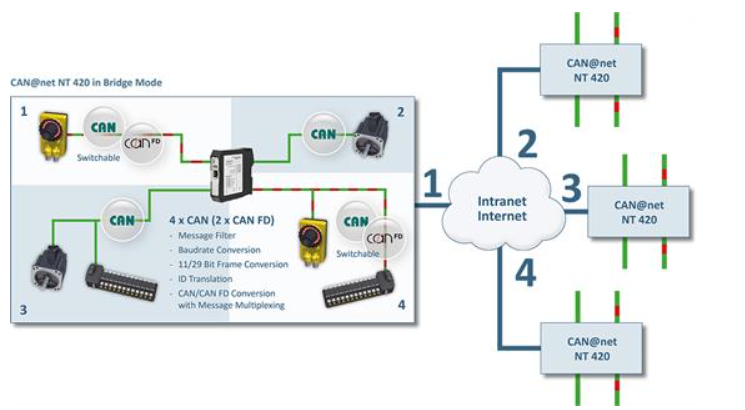 IoT CAN@net NT 220/420
IoT CAN@net NT 220/420
Intelligent CAN Adapter with
Ethernet Interface
Up to 4 x CAN (2 x CAN FD)
CAN-Ethernet gateway, bridge and PC interface
The CAN@net NT has two variants, CAN@net NT 200 with two classic CAN channels and CAN@net NT 420 with four CAN channels, of which two channels can be switched between CAN and CAN FD. Both devices offer three operation modes and can be used as a PC interface as bridge and gateway. Apart from this, the new IoT CAN@net NT 100 has a D-Sub 9 connector to facilitate CAN/CAN-FD network connectivity with the aforementioned CAN@net NT 200 and CAN@net NT 420.
Thanks to the new Service Pack 2 upgrade for the CAN@net NT and CANbridge NT series, these products are now ready to be implemented in IoT40 solutions. Using smart LUA scripting, this new update allows users to create event-controlled network actions for various cloud-based applications. It also allows users to utilize bi-directional MQTT telemetry that is versatile and easy to use.
How it works
CAN-Ethernet Gateway
In gateway mode the CAN@net NT can be directly accessed from e.g. Windows, Linux, VxWorks or QNX based systems as well as from embedded systems, by using a simple ASCII protocol over a standard TCP/IP socket. As CAN-Ethernet Gateway, the CAN@net NT offers easy, flexible access to four independent CAN systems (two CAN FD) via a LAN or via the Internet.
PC Interface
With the included VCI driver for Windows, the CAN@net NT can be operated like all IXXAT CAN PC interfaces. With the CAN@net NT, all VCI-based IXXAT tools, such as the canAnalyser, as well as customer-specific applications based on the VCI driver can be used. The VCI CAN driver offers the possibility to communicate with up to 128 CAN@net NT devices at the same time.

CAN-Ethernet-CAN Bridge
By using up to four CAN@net NT 420 (two CAN@net NT 200), a CAN-Ethernet-CAN bridge can be implemented, with each up to four independent CAN channels (2 for the CAN@net NT 200) per device. The bridge allows the exchange of CAN messages between CAN systems over long distances via TCP/IP, using existing Ethernet infrastructures. The segmentation of CAN systems also increases the reliability and failure safety of the entire system.
With the help of mapping tables, the exchange of messages between all channels can be configured very flexibly. Filter and conversion rules can be applied to the CAN and CAN FD messages. As a result, the bus load in the individual networks can be reduced since only relevant messages are transmitted to the other network. The data multiplexing functionality enables the mapping of e.g. CAN-FD data to several standard CAN messages.
